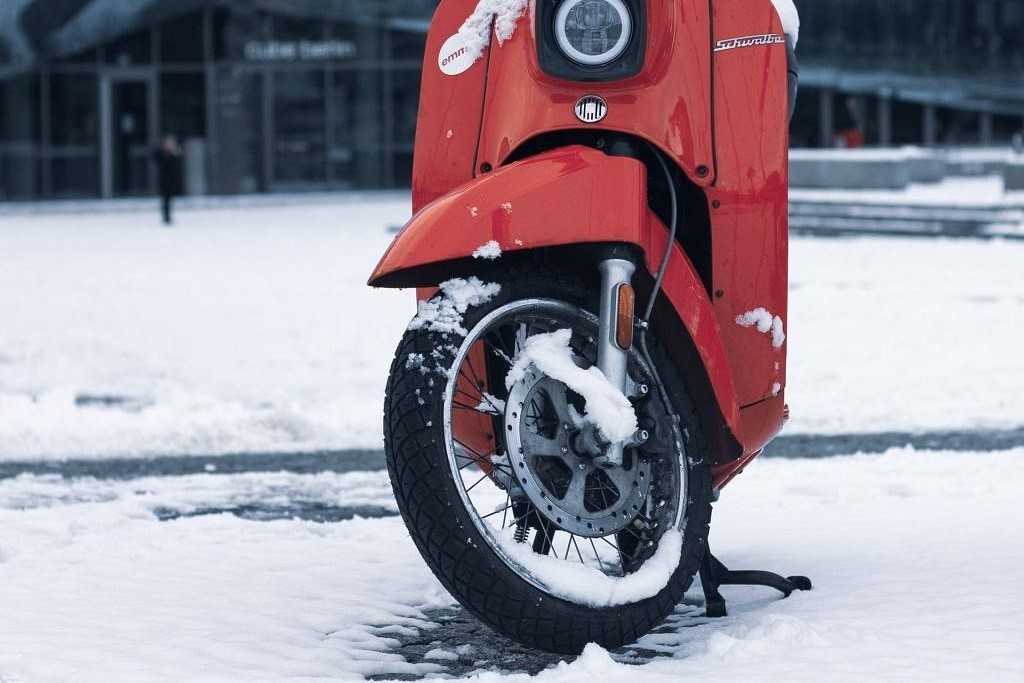As an Amazon Associate, we earn from qualifying purchases. We may get a commission when you purchase through our links, at no extra cost to you.
Proper maintenance and storing in the right place are the best ways to protect motorcycles in winter.
It’s no surprise that the cold can be harsh and unforgiving on a motorcycle. We know, we know, your buddy is a hunk and races on the roads like a king. But even kings need care…a fair bit more when the weather is cold. If you don’t store the motorcycle properly and take some precautions, your stylish hunk will catch corrosion and need you to shell out a lot in the repair shop.
Whether you ride in winter or not, your buddy needs extra care to stay in good health. In this article, we give suggestions for motorcycle winter care and storage tips, so it can be ready for riding next spring!
Protect Motorcycles In Winter: 4 Tips for Survival
The first thing to do when starting prepping for a cold winter is a little research, then do some shopping. Motorcycles house expensive parts held together with metal, rubber, and plastic.
Every joint and seal can be brittle or cracked when exposed to the cold weather elements during prolonged exposure periods. To survive winter, you need to do at least 4 things:
1. Cover the Chassis
Invest in a cover that can protect motorcycles in winter from dust, dirt, and moisture. It’d be great if it can provide protection from UV rays too since that damages different plastics and rubbers.
A cover with a cloth shell will keep water away from your bike in case of an unexpected afternoon shower!
2. Find a Dry, Warm Place
When it starts snowing, find a dry indoor place to store your motorcycle. Ideally, you want to find a heated storage space with climate control that stays between 50 to 55 degrees Fahrenheit during the cold months.
If you are storing motorcycle for winter outside, arrange for a dry place that protects it from weather elements.
3. Protect the Engine
It’s important to protect the engine with oil-based or synthetic motor oil as a barrier against moisture and oxygen. Take extra precautions because cold weather can accelerate corrosion.
Before you store your motorcycle for winter, change the oil, check for leaks (especially antifreeze leaks), so any remaining water there evaporates before spring comes around.
4. Check Tire Pressure
Check tire pressure regularly during this time of year because tires deflate faster due to lower temperatures. A simple gauge is enough for checking the pressure, which should be at a minimum of 18 to 25 psi.
You might also want to invest in snow tires, so climbing uphill won’t be such a challenge. Snow tires are meant specifically for snowy conditions, which means they’re going to grip better than regular ones… but obviously most experts recommend that you just avoid those conditions if possible.
How to Prep the Motorcycle for Long-term Storage
To protect motorcycles in winter, proper storage is essential. Especially, avoid wet areas like the basement as it can cause rust on metal parts. To prepare it for long-term storage, follow these steps:
Clean the Motorcycle
Before storing the motorcycle, clean it or dirt can have adverse effects on the metal parts as well as paintwork. Plus, salt and other chemicals on the road can create pitting and rust.
It’s a good idea to purchase a liquid-based degreaser to wipe all metal parts with it and remove any residue leftover from the previous cleaning.
Check the Fluids
Check all fluids like brake fluid and coolant to make sure that everything is topped. Treat the gas tank with fuel stabilizer, so these critical systems aren’t compromised when you’re out on a ride or track day.
Use a Cover
Protect your bike from corrosion and weathering by installing a cover with a secure fit. Make sure the cover doesn’t trap moisture and prevents water from entering the radiator and air box.

Dowco Guardian 50005-02 WeatherAll Plus Indoor/Outdoor Waterproof Motorcycle Cover
FEATURES WE LIKED
- Heavy-duty waterproof ClimaShield Plus fabric
- Sealed seams for maximum water resistance
- Heat shields to prevent melting from exhaust
- Solution-dyed for UV and fade resistance
- Comes with compression storage bag
You need to do extra care to protect motorcycles in winter and storing it indoors during those months will keep it in a good condition.
A climate-controlled space that keeps moisture and humidity in check is the best option. But if this isn’t an option, then go ahead and use a dehumidifier which can help protect against corrosion from humidity.
How to Store a Motorcycle for 6 Months
Sometimes, you may need to store the motorcycle for a longer period; not just a few months of winter. The engine and other parts of a motor vehicle get affected when it remains inactive for months. To keep the bike in good condition, follow these tips:
Look for leaks. Make sure there are no leaks and try not to park next to corrosive materials, such as salt or acid. Fix if there are any leaks anywhere, so when you pull the motorcycle out next spring, all systems are ready to go!
Wipe before storing. Bikes made of aluminum won’t catch rust. In case of other metals, wipe it off with a dry cloth and store it in a warm place. This will dry off the water left unintentionally.
Don’t use chains. To protect motorcycles in winter, never put chains around wheels because they’ll cause more damage than anything else.
Use floating storage. If possible, use a floating storage, so the tires are high of the ground by at least four inches.
Or keep the bike upside down. It will be better to store the motorcycles upside down or vertically on a wall when parked for six months. This keeps the fork seals lubricated.
Change the oil and replace the filter. If you want your bike to be ready for winter, it’s a good idea to change the oil and filter before you put it up for the season.
Run the engine occasionally. Start your bike every month or two during storage and let it run out of gas. This will help prevent condensation from forming in carburetors and clogging fuel lines with moisture. It also keeps an important layer of lubrication on moving parts like piston rings and bearings.
Take extra care of the battery. Don’t forget about battery life. It will last longer by keeping away from moisture sources like water heaters or dryers, which could compromise its insulation.
Conclusion
Following all these tips will help you protect motorcycles in winter. When stored indoors throughout the colder months, do all necessary checks and maintenance to make sure there is no condensation or water build-up anywhere on your bike.
FAQs about Protect Motorcycles in Winter
Why store my motorcycle?
Exposure to winter elements is never good for a motorcycle. Water can seep into any opening and cause damage. It can cause rust, which means you’ll have to replace parts sooner than usual. Rust also leads to lock and key issues should you need to ride in winter conditions. The cold can even dull spark plugs, making your bike hard or impossible to start.
How long should I store my bike?
Ideally, you’d store your motorcycle from October through March of the following year. If you cannot store your bike for such a long period, you should at least park it indoors, so the elements don’t get to it. Just be aware that leaving a motorcycle outside even for a few months can cause damage.
Can I store my motorcycle outside during winter?
No, you should never store your motorcycle outside during winter. This is hazardous to the bike and will cause damage like rusting of components from water seeping through cracks in the pavement or snowdrifts accumulating on it. If you cannot keep it inside a garage or shed, cover it with a tarp or plastic sheet. These sheets have vents all around to prevent moisture condensation – this is one way to protect the paint finish too!
What is a motorcycle stand for winter storage?
A motorcycle stand is a piece of equipment that helps you get your bike in the right position for storage. It keeps the bike off the ground and makes it easier to clean or change the oil.
How much does motorcycle winter storage cost?
When you don’t have your own garage, renting a storage facility is the best solution. The cost of motorcycle winter storage varies from location to location. The monthly cost of a 5×10 storage unit is around $60 to $70 while a smaller 5×5 unit could be between $45 and $55. The cost is worth it for those who want their bike both protected, clean before next season, and get ready for spring with less stress!
Should I cover my motorcycle for winter?
Yes! Covering a motorcycle provides protection from snow, ice, dirt, and UV damage that can happen over winter. A breathable cover allows moisture to escape while blocking most elements.
Do I need to start my motorcycle during storage?
It is recommended to start your motorcycle occasionally, at least once a month if possible during the winter months. This keeps components lubricated and prevents seals from drying out. Let the engine run for 10-20 minutes each time.
How do I lift my motorcycle for storage?
Use a sidestand pad, rear paddock stand, or centerstand with a rear pad to keep tires off the ground. You can also place the bike on a motorcycle lift. Lifting the bike reduces flat spots on tires and stress on tires, suspension and other components.
Should I drain gasoline from the tank for winter?
No, most experts recommend leaving fuel in the tank with stabilizer for winter storage. Draining the fuel system can introduce moisture and is more work to re-fill the tank in the spring.
How do I protect chrome parts during storage?
Apply a thin coat of wax, grease, oil or rust inhibiting spray to chrome parts. This forms a barrier to protect against moisture and corrosion over winter. Reapply as needed throughout the storage period.
Should I put my motorcycle on ramps for storage?
Motorcycle ramps allow easier access for routine checks and make it easier to start the bike without lifting it. Ramps provide better ventilation under the motorcycle compared to using a paddock stand, although either option works well for winter storage.




